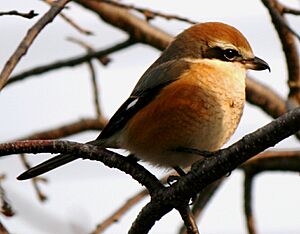Bull-headed shrike facts for kids
Quick facts for kids Bull-headed shrike |
|
|---|---|
 |
|
| Conservation status | |
| Scientific classification | |
| Genus: |
Lanius
|
| Species: |
bucephalus
|
The bull-headed shrike (scientific name: Lanius bucephalus) is a small songbird. It lives in eastern Asia. This bird is part of the shrike family, called Laniidae.
Contents
What Does It Look Like?
This bird is about 19 to 20 centimeters (7.5 to 7.9 inches) long. Male bull-headed shrikes have a brown top of the head. They have a white stripe above their eye. A black "mask" goes across their eyes. Their back is grey-brown. Their wings are dark with a white spot. The sides of their body are reddish-brown. The rest of their belly is whitish with thin stripes.
Female shrikes look similar to males. However, their colors are not as bright. They are browner overall. Females have a brown mask instead of a black one. They also do not have the white spot on their wings. These birds make loud, rough calls. They can also copy the sounds of other birds.
Where Do They Live?
Bull-headed shrikes breed in several places. These include northeast China, Korea, Japan, and far-eastern Russia. This part of Russia includes areas like Ussuriland, Sakhalin, and the Kuril Islands.
Birds that live in the north fly south for winter. Some even reach southern China. A few have been seen in places like Taiwan, Hong Kong, and Vietnam. There is a special group of these birds called sicarius. They live only in the mountains of Gansu Province in west-central China.
Where Can You Find Them?
These shrikes like open areas. You can often find them in farmland. They also live at the edges of woodlands. Sometimes, they visit parks and gardens in cities.
The bull-headed shrike likes to sit on a high spot. From there, it waits for food to pass by. They mostly eat insects. This includes beetles and crickets. They also hunt lizards and crustaceans.
How Do They Hunt?
The bull-headed shrike is known for a special hunting trick. Like some other shrikes, they can impale their prey. This means they stick their food onto something sharp. They often use thorns for this. This helps them tear their food into smaller pieces. They might also do this to store food for later. Sometimes, they use impaled prey to mark their territory.
Reproduction and Life Cycle
Bull-headed shrikes build their nests in bushes or bamboo plants. The female bird lays two to six eggs. The eggs are kept warm for 14 to 15 days. This process is called incubation. The young birds leave the nest about 14 days after they hatch.


